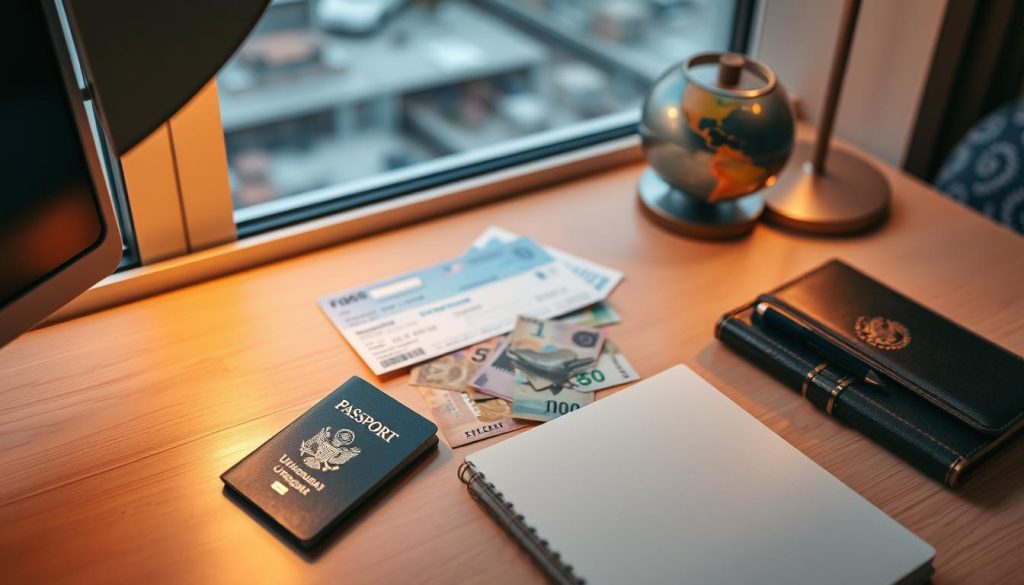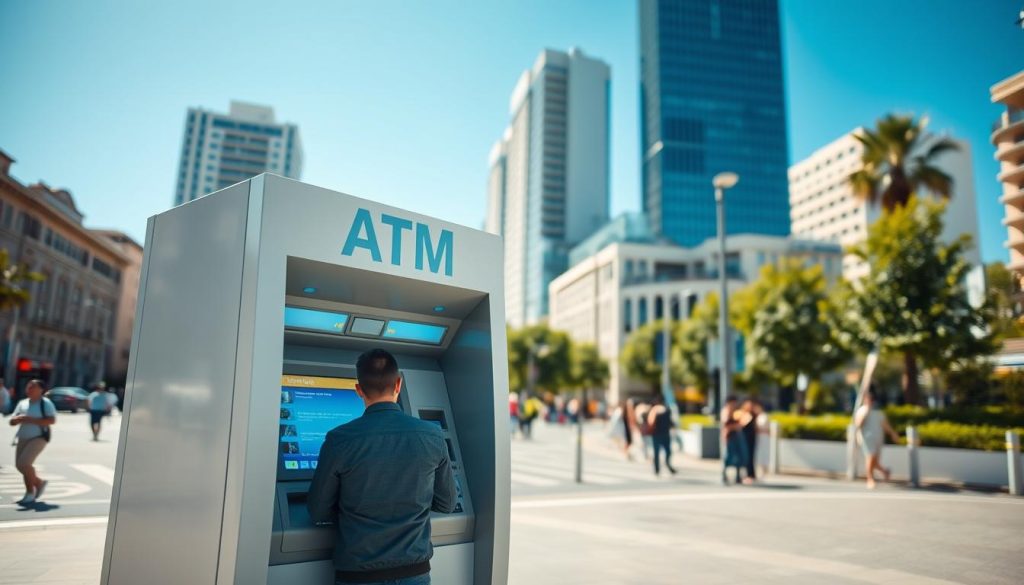✓ Accommodations ✓ Flights ✓ Rental Cars ✓ Tours & Activities
Did you know that 90% of transactions in Uruguay are conducted in the local currency, the Uruguayan Peso (UYU)? This means that planning your trip with the right currency in mind is essential for a smooth experience.
Whether you’re exploring Montevideo or relaxing on Punta del Este’s beaches, understanding the Uruguayan Peso and payment methods will save you time and money. This guide will walk you through everything you need to know, from exchange rates to the best ways to pay during your travel.
Preparing ahead is key. Unlike some destinations, USD or AUD aren’t widely accepted here. Carrying cash in UYU or using a travel-friendly card can make your trip hassle-free. Let’s dive into the details to ensure you’re fully prepared for your adventure!
Understanding Uruguay’s Currency Landscape
Navigating the currency landscape can make or break your trip. The official currency here is the Uruguayan Peso (UYU), and it’s the only legal tender accepted nationwide. Whether you’re shopping in Montevideo or dining in Punta del Este, having UYU on hand is essential.
When exchanging money, you’ll encounter the mid-market rate—the real-time rate banks use to trade currencies. However, most exchange services add a markup fee, which can increase your costs. For example, the USD/UYU or AUD/UYU rates you see online might differ from what’s offered at local banks or exchange offices.
Markups and additional fees can add up quickly. To avoid overpaying, monitor live exchange rates using currency conversion sites. This helps you recognize fair rates and make informed decisions. Understanding these basics can save you money and ensure a smoother experience during your travels.
Official Currency & UYU Basics
The Uruguayan Peso is the backbone of all transactions. Unlike some destinations, foreign currencies like USD or AUD aren’t widely accepted. Carrying UYU ensures you’re prepared for everything from taxis to local markets.
Exchange Rate Markups Explained
Exchange providers often charge a markup on the mid-market rate. This means you’ll get fewer pesos for your dollars or euros. Always compare rates and fees before exchanging money to maximize your budget.
Preparing for Your Payment Options in Uruguay
Planning your payment strategy in advance ensures a smoother travel experience. Exchanging currency before you leave can save you time and money. By preparing early, you’ll have better control over exchange rates and avoid unnecessary fees.

One of the best ways to manage your travel money is to exchange funds before your trip. This allows you to lock in a favorable exchange rate and avoid last-minute stress. Using tools like the Wise Multi-Currency Card can also help you save on fees and access competitive rates.
Pre-trip Currency Exchange Tips
Exchanging currency in advance often yields better rates and lower costs. Compare offers from different providers to find the best deal. Checking the mid-market rate beforehand ensures you’re getting a fair exchange.
Here are some practical steps to consider:
- Research exchange services with low fees and transparent rates.
- Use a travel-friendly card like Wise for everyday spending.
- Withdraw cash in larger amounts to minimize transaction fees.
By planning ahead, you can avoid the higher costs of exchanging money upon arrival. This simple step can lead to considerable savings and a more enjoyable trip.
Uruguay: Ultimate Travelers Guide to Currencies & Payments – In-Depth Payment Strategies
Selecting the right payment method can significantly impact your travel budget. Whether you’re shopping, dining, or exploring, choosing wisely can save you money and hassle. Let’s dive into strategies to help you make the best decisions.
Choosing the Right Payment Method
When deciding how to pay, consider factors like fees, ease of use, and acceptance. A travel-friendly debit card can be a great option. These cards often offer low foreign transaction fees and real-time currency conversion.
For example, cards like Wise allow you to hold multiple currencies and convert them at the mid-market rate. This can save you money compared to traditional bank cards. Always check for hidden charges before making a decision.
Managing Foreign Transaction Fees
Foreign transaction fees can add up quickly. These fees are typically a percentage of each purchase made abroad. To avoid them, look for cards that waive these charges or use a multi-currency account.
Here are some tips to minimize fees:
- Use a debit card designed for travel, like Wise, which offers transparent fees.
- Pre-convert currency to lock in favorable rates and avoid last-minute markups.
- Withdraw cash in larger amounts to reduce ATM fees.
By planning ahead, you can keep more money in your pocket and enjoy a smoother travel experience.
Exchanging Money: Options Before and After Arrival
Knowing where and when to exchange money can make a big difference in your travel budget. Whether you choose to convert your cash before departure or upon arrival, each option has its pros and cons. Understanding these can help you save money and avoid unnecessary fees.

Pre-departure vs. Arrival Exchange Rates
Exchanging money before your trip often gives you better control over the rate. Banks and currency exchange services in your home country may offer competitive rates, especially if you plan in advance. For example, Bank of America’s rates are approximately 6% more favorable than IMF rates.
On the other hand, waiting until arrival might seem convenient, but rates at airports are often less favorable. Airport exchanges can charge up to 14% more than the mid-market rate. This markup can significantly reduce the amount of local currency you receive.
Avoiding Airport Currency Traps
Airports are notorious for high fees and poor exchange rates. Instead of converting your money there, consider using ATMs or local exchange providers in city centers. These options usually offer better rates due to competition and market conditions.
Here’s a quick comparison of your options:
| Option | Pros | Cons |
|---|---|---|
| Pre-departure Exchange | Better rates, no last-minute stress | May require planning ahead |
| Airport Exchange | Convenient | High fees, poor rates |
| Local ATMs/Providers | Competitive rates, widely available | May have withdrawal limits |
By planning ahead and avoiding airport traps, you can keep more cash in your pocket. Exchanging a small amount before your trip and relying on trusted ATMs or cards during your stay is a smart strategy.
Leveraging Travel Debit and Credit Card Options
Choosing the right payment tools can transform your travel experience. Whether you’re shopping, dining, or exploring, the right travel card can save you money and simplify your journey. Let’s explore the benefits of using debit and credit cards designed for travelers.
Benefits of a Travel Debit Card
A travel debit card is a must-have for any trip. These cards are designed for international use, offering low fees and secure transactions. With a travel-friendly debit card, you can withdraw cash from ATMs worldwide without worrying about excessive charges.
One of the biggest advantages is real-time currency conversion. This means you’ll always know exactly how much you’re spending in your home currency. Plus, many travel cards come with built-in security features, like fraud protection and spending alerts.
Using the Wise Multi-Currency Card
If you’re looking for a versatile option, the Wise Multi-Currency Card is a game-changer. This card allows you to hold and convert money in over 50 currencies at the mid-market rate. Say goodbye to hidden fees and hello to transparent, cost-effective spending.
With Wise, you can manage your budget effortlessly. The card’s app lets you track expenses and convert currencies on the go. It’s perfect for travelers who want to avoid the hassle of carrying cash or dealing with poor exchange rates.
“Using Wise has saved me hundreds in fees during my travels,” says one satisfied user. This card is a smart choice for anyone who values convenience and savings.
When comparing credit cards and debit cards, consider your spending habits. Credit cards often offer rewards and purchase protection, but they may come with higher fees. Debit cards, especially those like Wise, are ideal for budget-conscious travelers who want to avoid debt.
Here’s a quick tip: Always check for foreign transaction fees before choosing a card. Many travel-friendly options, including Wise, eliminate these charges, making them a cost-effective choice for international trips.
Budgeting Your Trip: Money Matters in Uruguay
Managing your travel budget effectively can make your trip more enjoyable. Understanding your daily costs and planning ahead ensures you stay on track. Whether you’re a budget traveler or prefer luxury, balancing your spending is key to a stress-free experience.

Daily Cost Breakdown
Your daily budget will vary depending on your travel style. Here’s a quick breakdown of average costs:
| Category | Budget | Mid-Range | Luxury |
|---|---|---|---|
| Accommodation | UYU 593 | UYU 1,483 | UYU 3,221 |
| Food | UYU 413 | UYU 975 | UYU 1,992 |
| Transportation | UYU 636 | UYU 636 | UYU 636 |
| Entertainment | UYU 636 | UYU 636 | UYU 636 |
These estimates help you plan your spending and allocate money wisely. Adjust your budget based on your preferences and activities.
Travel Style Budgeting Tips
No matter your travel style, these tips can help you stay on budget:
- Track your spending: Use apps or a notebook to monitor daily expenses.
- Balance cash and cards: Carry some local currency for small purchases and use cards for larger transactions.
- Avoid hidden fees: Choose travel-friendly cards with low foreign transaction fees.
- Plan ahead: Book accommodations and activities in advance to lock in better rates.
By maintaining a healthy balance between cash and card payments, you can avoid overspending and enjoy your trip without financial stress.
Remember, a well-planned budget ensures you get the most out of your adventure. Start tracking your costs today and make your journey unforgettable!
Finding the Best Currency Exchange Rates
Securing the best exchange rate can make your travel budget go further. The mid-market rate is the benchmark for fair pricing, but many providers add markups that increase your costs. Understanding how to monitor and compare rates ensures you get the most value for your money.
Monitoring Mid-Market Rates
The mid-market rate is the real-time rate banks use to trade currencies. It’s the fairest benchmark, but most exchange services add a markup. Tools like Wise and XE Currency provide live updates, helping you track the market and avoid overpaying.
Here’s how to stay informed:
- Use currency conversion apps to monitor live exchange rates.
- Compare rates from multiple providers to find the best deal.
- Avoid airport exchanges, which often have the highest markups.
Comparing Exchange Providers
Not all providers offer the same rate. Some embed fees in the exchange, while others charge upfront. Always check the final price you’ll pay, including any hidden costs. Here’s a quick comparison:
| Provider | Pros | Cons |
|---|---|---|
| Banks | Secure, reliable | Higher fees, slower process |
| Online Services | Competitive rates, fast | May require advance planning |
| Airport Exchanges | Convenient | High markups, poor rates |
By planning ahead and comparing options, you can secure the best exchange rate and save money for your travels.
Payment Methods: Cash vs. Card in Uruguay
Deciding between cash and card payments can shape your travel experience. Both options have their advantages and drawbacks, depending on your needs. Understanding when to use each can save you money and ensure convenience.
Pros and Cons of Cash
Using cash is ideal for small transactions, like tipping or buying snacks. It’s widely accepted and helps you avoid foreign transaction fees. However, carrying large amounts can be risky and inconvenient.
Here are some key points to consider:
- Convenience: Cash is perfect for quick, small purchases.
- Security: Keep only what you need and store the rest safely.
- Cost: No additional fees, but exchanging money may involve markups.
Pros and Cons of Card Payments
Cards, especially those with low foreign transaction fees, are great for larger purchases. They offer security and ease of use, but some services may charge extra fees.
Here’s what to keep in mind:
- Convenience: Cards are widely accepted in hotels and restaurants.
- Security: Use cards with fraud protection and notify your bank before traveling.
- Cost: Watch out for foreign transaction fees and dynamic currency conversion.
Balancing both cash and card payments is the best option. Use cash for small expenses and cards for larger ones. This approach ensures flexibility and minimizes risks.
| Option | Pros | Cons |
|---|---|---|
| Cash | No fees, widely accepted | Risk of theft, less convenient for large amounts |
| Card | Secure, easy to track spending | Potential fees, not accepted everywhere |
By understanding the strengths and weaknesses of each service, you can make informed decisions. This balance will help you manage your budget and enjoy a hassle-free trip.
Traveler Tips: Avoiding Extra Fees and Hidden Charges
Traveling smart means avoiding unnecessary fees that can eat into your budget. From dynamic currency conversion to foreign transaction fees, small charges can add up quickly. With a few simple strategies, you can save money and enjoy a hassle-free trip.
Spotting Dynamic Currency Conversion
Dynamic currency conversion (DCC) is a common fee trap. When paying with a card, you might be asked if you want to pay in your home currency instead of the local one. While it sounds convenient, this option often comes with higher transaction fees and poor exchange rates.
To avoid this, always choose to pay in the local currency. Review your receipts carefully to ensure you’re not being charged extra. For example, a $100 purchase could cost you $103 or more with DCC. Declining this option can save you money over time.
Reducing Foreign Transaction Fees
Foreign transaction fees are another common expense. These fees are typically 1-3% of each purchase made abroad. To minimize them, use a travel-friendly card like Wise, which offers transparent fee structures and real-time currency conversion.
Here are some practical tips to reduce fees:
- Choose the right card: Look for cards with no foreign transaction fees.
- Pre-convert funds: Lock in favorable rates before your trip.
- Withdraw cash wisely: Take out larger amounts to minimize ATM fees.
| Fee Type | How to Avoid |
|---|---|
| Dynamic Currency Conversion | Pay in local currency, decline DCC offers |
| Foreign Transaction Fees | Use fee-free cards, pre-convert funds |
| ATM Fees | Withdraw larger amounts, use partner ATMs |
By understanding these fees and taking proactive steps, you can keep more money in your pocket. A little planning goes a long way in making your travel experience smoother and more affordable.
Planning and Managing Your Currency On the Go in Uruguay
Accessing cash safely and securely is a key part of any trip. Whether you’re exploring cities or relaxing in rural areas, knowing how to manage your funds ensures a smooth experience. Let’s dive into strategies for using ATMs effectively and keeping your money secure.

ATM Withdrawal Strategies
Using ATMs is one of the most convenient ways to access cash. However, fees and exchange rates can vary. To save money, choose ATMs affiliated with major banks or multi-currency providers. These often offer competitive rates and lower fees.
Here are some tips for efficient atm withdrawals:
- Withdraw larger amounts to minimize transaction fees.
- Decline dynamic currency conversion to avoid poor exchange rates.
- Use a travel-friendly debit card with low foreign transaction fees.
By planning your withdrawals, you can reduce costs and ensure you always have cash on hand.
Securing Your Money During Travel
Keeping your money safe is just as important as managing it. Use a combination of cash and cards to minimize risks. For example, carry only the cash you need for the day and store the rest securely.
Here’s how to safeguard your funds:
- Use a multi-currency account to manage different currencies in one place.
- Notify your bank before traveling to avoid blocked transactions.
- Choose ATMs in well-lit, secure locations to reduce the risk of theft.
These simple steps can help you enjoy your trip without worrying about your finances.
| Strategy | Benefit |
|---|---|
| Use bank-affiliated ATMs | Lower fees, better rates |
| Decline dynamic currency conversion | Avoid poor exchange rates |
| Carry a travel-friendly card | Low foreign transaction fees |
By following these strategies, you can manage your account and transactions efficiently. A little planning goes a long way in ensuring a stress-free travel experience.
Conclusion
Making the most of your trip starts with smart money management. This guide has covered essential tips on currency exchange, payment methods, and avoiding extra fees. By preparing in advance and using reliable tools, you can ensure a smooth and cost-effective experience.
Remember, exchanging cash before your travel or using a travel-friendly card like Wise can save you both time and money. These strategies help you avoid unnecessary costs and focus on enjoying your journey.
Take a moment to review the key sections of this site to plan your unique needs. Whether you’re exploring a new city or relaxing in a quiet corner of the world, proper preparation makes all the difference.
Ready to take the next step? Research the best exchange rates and payment options to ensure a worry-free trip. With the right tools and knowledge, you’re set for an unforgettable adventure.
The above is subject to change.
Check back often to TRAVEL.COM for the latest travel tips and deals.






